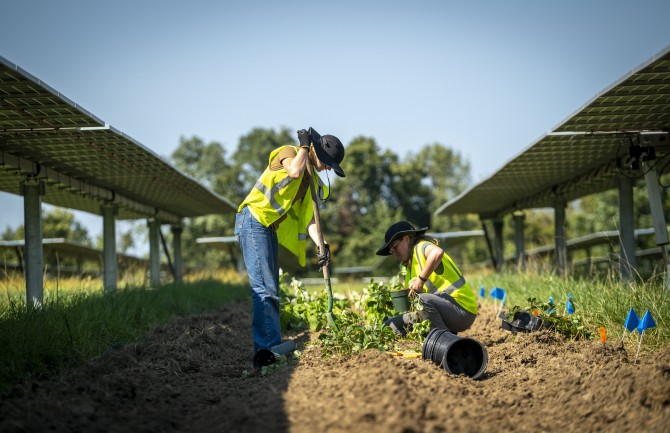This is Part 3 in a five-part multimedia feature examining Cornell's cutting-edge, interdisciplinary contributions to solar energy research as New York state works to achieve its goal of 70% renewable energy by 2030.
Not everyone is excited about New York's rapid solar expansion.
The buildout of solar energy infrastructure across the state has become an issue of grave concern for many farmers and those worried about the state's agricultural communities. The U.S. Department of Energy estimates that 10 million acres will be needed to meet solar energy production goals by 2050, and American Farmland Trust estimates 80% of that could be built on agricultural lands. A Cornell study found that approximately 84% of land identified as suitable for future solar development in New York state is agricultural.
"One of the big questions is always, how will landowners, both farmers and non-farmers, respond to solar leasing opportunities?" said Rich Stedman, professor of natural resources and the environment in the College of Agriculture and Life Sciences (CALS). "Some people fear this will be the death of farming, that people are going to lease their acres for solar panels and that'll be it - it will be an 'exit strategy' and that land will be lost to production. Other people have hypothesized that the additional income will enable people who want to stay in farming to do so."
Stedman studies the social science dynamics of energy transformations, and has conducted surveys and focus groups with farmers and other landowners. One recently completed survey of New York state landowners living near transmission lines and electricity substations found that farmers were more opposed than non-farmers to large-scale solar development in their area, and that farmers were more likely than non-farmers to be approached by solar developers but less likely to lease their land.
The research also found that among farmers who have leased their land, about half expect to continue producing agricultural products on the land with solar panels - a process called agrivoltaics, which has seen a great leap in Cornell research activity.
Graduate student Dana Russell (left) and extension associate Caroline Marschner, who co-leads the Cornell Agrivoltaics Research program, plant crops to study how they can flourish under solar panels.
In 2024, with $1 million in initial support from New York state, CALS established the Agrivoltaics Research Program to bring together dozens of researchers across campus and external partners to explore the engineering, agronomics, economics, policy and social science of agrivoltaics.
"So there certainly is interest in this idea of agrivoltaics, but people want a lot more information about what that would actually mean for their farms," Stedman said. "Because agricultural land is so 'in the crosshairs' with utility-scale solar, it's very important that we figure out how to avoid prime farmland and how to work with farmers in a way that honors what they actually do and want to do."
An equally important factor, according to Max Zhang, the Irving Porter Church Professor of Engineering in Cornell Engineering and Provost's Fellow for Public Engagement: What will it cost energy consumers?
"The cost-effectiveness of agrivoltaics systems is crucial to market adoption and the overall energy transition," said Zhang, whose team conducted the New York state land-use analysis. "As solar becomes a major source of electricity generation in the near future, we must ensure electricity remains affordable for the public."








